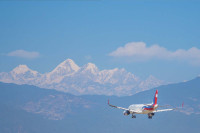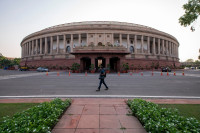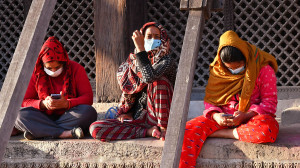Opinion
Gobbling globalisation
Even after more than two decades, Nepal has not gained much from integration with the global economy
Bijendra Man Shakya
This year marks the 25th year since Nepal initiated the process of economic globalisation in the early 1990s by taking three bold steps. First, it liberalised trade by unilaterally dismantling tariff barriers and allowing foreign investment in previously restricted sectors. Second, it adopted a flexible exchange system for the rupee in the trade of goods and services. Third, it demonstrated commitment to regional and multilateral trading systems by initiating negotiations to join the Agreement on South Asian Free Trade Area (Safta) and the World Trade Organisation (WTO) respectively.
Apparently, all the three approaches aimed at increasing economic integration across the world have worked well for Nepal. The tariff barrier to trade has been reduced drastically—average applied tariff of 40 percent during the pre-liberalisation era has drastically lowered to about 13 percent currently, and most products fall in the rate of below 10 percent. Similarly, the flexible exchange rate for the rupee has discouraged its over-valuation and maintained exchange stability to some extent. And Nepal is already a full-fledged member of both the Safta and the WTO, which promote impartial trading systems and challenge unfair trade practices among countries.
Nothing to rejoice
But economic liberalisation has barely offered anything concrete to Nepali reformists. At first glance, the two key economic globalisation indicators of trade and investment sectors—import and export—have evolved disappointingly for Nepal. Instead of narrowing the gap between export and import transactions, the liberalisation policy widened it to an alarming level—while the imports have skyrocketed, the exports have dropped exponentially. During the period of two and half decades, the import value as a percent of GDP increased from the 10-year average of 22 percent (1981-1990) to 35 percent (1991-2000), whereas the export value rose from 12 to 22 percent only. It was even worse after 2000 as imports increased from 25 percent in 2003-04 to 32 percent in 2009-10 and further to 36 percent in 2014-15 against 10, 5.2 and 4 percent respectively for exports.
The disparity between the trends in exports and imports has, therefore, worsened the country’s trade balance—so much so the deficit that grew by three times in the first 10 years of the reform (1991-2001) swelled by five-fold in the next 10-year period. The unprecedented rise in the deficit crossed a staggering Rs800 billion in 2015-16. This is equivalent to almost a third of the current GDP.
If the trade sector performance seems worrisome, the investment scenario looks even gloomier. The sluggish investment growth in the manufacturing sector and its meager contribution to GDP, which plunged from 10 percent in the initial years of liberalisation to a scanty 4 percent in later years, clearly reveal the sad scenario of domestic investment in the country. Also, there is no reason to be satisfied with foreign investments, which account for less than 1 percent of GDP. The foreign investment flow in Nepal is one of the lowest among the least-developed countries.
Being part of the globalised world has not only served Nepal poorly in terms of trade and investment, but also in terms of migration, the third most important aspect of globalisation. Although the remittances sent by Nepali migrant workers have contributed significantly to poverty reduction in the country, they have not been able to contribute directly to the overall macroeconomic indicators of the economy. This is because Nepal has been mired in a vicious cycle of workers’ migration and growing remittances sent back home, which in turn encourages the importation of goods, ultimately reducing the competitiveness of the local manufacturing sector. To make the situation worse, migration of workers has in fact intensified the labour problem in all productive sectors. As a result, neither were the import-competing industries encouraged, nor could the export-oriented ones flourish. Instead, the economy has become dependent on remittances at the cost of domestic sectors. In that sense, the Nepali economy became overly dependent on cross-border trade, instead of being interdependent, which is what economic globalisation is supposed to do.
It’s about institutions
All these developments have posed one critical question: why has Nepal had to face these paradoxical situations? One explanation could be that the reformists in the country took globalisation for granted. The post liberalisation policies trusted the functioning of the market too much, expecting that the integration into the global economy will automatically lift the national economy up. They failed to respond appropriately to market imperfections as reflected by policy flaws in the country. Some telling examples are that Nepal’s tariff regime still has relatively higher taxes on inputs imported for production. The investment policy imposes unnecessary caps on foreign ownership and requires lengthy processes to recruit foreign workers and remit profits made by foreign investors. There are inappropriate and inadequate incentives to uplift the sectors with a comparative advantage.
There are striking examples of globalisation being a boon to many developed and developing economies. China and India have managed to adapt to the wave of globalisation by pursuing mixed strategies instead of opening their economies unconditionally. Today, China has established itself as the world’s factory, whereas India has made great strides in the international service sector through its outsourcing hubs. But there are also unforgettable incidents of financial crises that hurt the economies of the countries in South-East Asia and Latin America—crises that were tied excessively to globalisation. So it is not whether globalisation is good or bad. It is about creating new institutions and compensation mechanisms through policy intervention at home that will render globalisation more effective and more sustainable.
Shakya is an associate professor of economics at Tribhuvan University




 14.12°C Kathmandu
14.12°C Kathmandu








%20(1).jpg&w=300&height=200)

